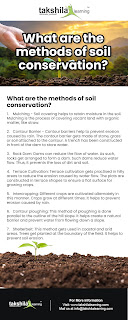Erosion of Soil
The erosion of topsoil is referred to as erosion. Deforestation, overgrazing, excessive use of fertilisers or pesticides, precipitation flow, landslides, and floods are all possible causes of erosion.
What are the soil conservation methods?
Mulching - Mulching aids in the retention of moisture in the soil. Mulching is the practise of covering undeveloped area with organic debris such as straw.
Contour Barriers — Contour barriers aid in the prevention of rain-induced erosion. Stone, grass, or dirt connected to the contour forms the contour barrier. To store water, a trench has been dug in front of the dam.
Dams, such as rock dams, can impede the flow of water. As a result, rocks are arranged to create a dam. Dams like these impede water flow. As a result, dirt and soil are not lost.
Terrace Cultivation: In steep places, terrace cultivation is utilised to decrease erosion caused by water flow. To maintain a flat surface for growing crops, the plots are built in terrace designs.
Intercropping: In this method, different crops are planted alternately. Crops mature at various periods. It aids in the prevention of rain-induced erosion.
Contour ploughing is a type of ploughing that is done parallel to the hill slope's outline. It aids in the formation of a natural barrier that keeps water from flowing down a hill.
Shelterbelt: In coastal and dry areas, this strategy is applied. Trees are placed along the field's edge. It aids in the prevention of soil erosion.
Read more about Soil Profile and Soil Preparation
Tag - what is soil, soil erosion, soil , NCERT Class 7 Science, Class 7 Science Chapter 9 – Soil

Comments
Post a Comment
Thank you we will contact ASAP.